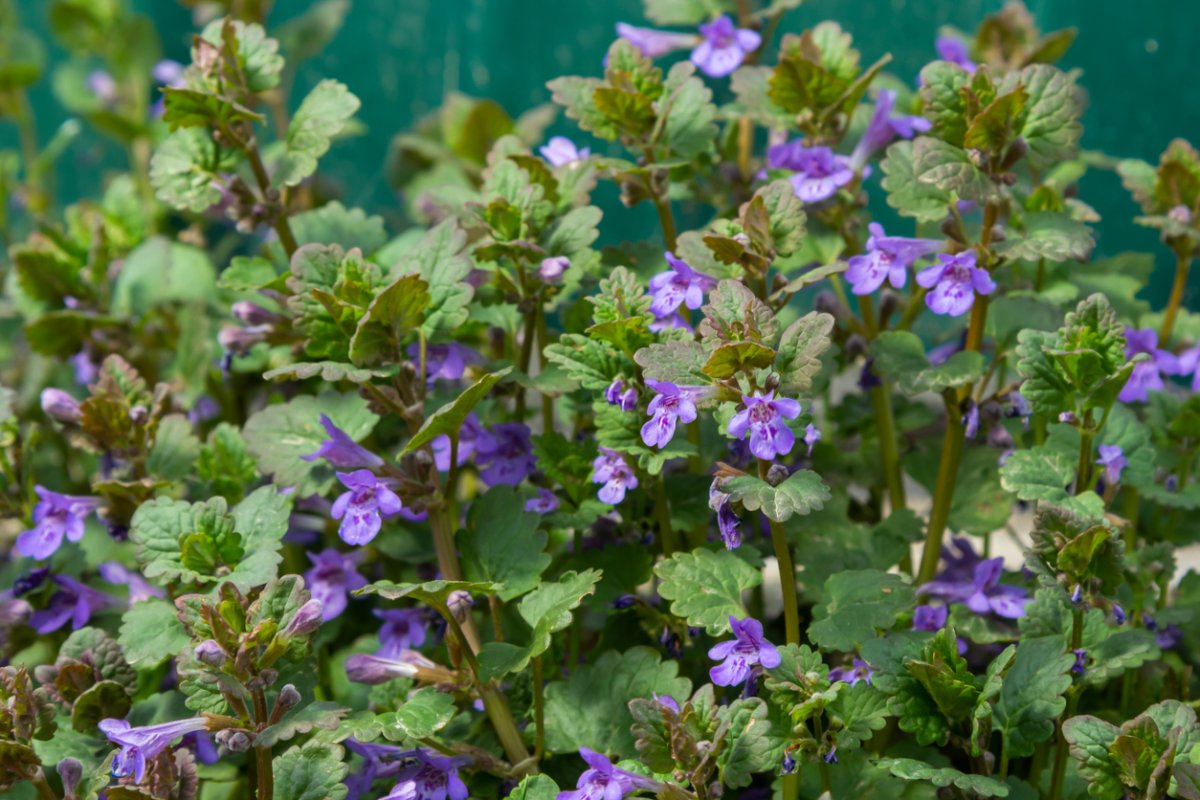We may earn revenue from the products available on this page and participate in affiliate programs. Learn More ›
Creeping Charlie or Glechoma hederacea, also commonly known as ground ivy, is an insidious weed that is both resilient and adaptable, making it very difficult to control successfully. This member of the mint family has plenty of aliases, including cat’s foot and runaway robin. It quickly fills empty spaces and can overpower grass or other plants.
“Promoting a dense and healthy lawn is the best defense against weeds, including creeping Charlie,” says John Kaminski, Ph.D., professor of turfgrass management at The Pennsylvania State University. The weed thrives in moist and shady areas, where grass and some ground covers don’t grow well. If you see it, act fast, or you will have a tough battle ahead.
What does creeping Charlie look like?
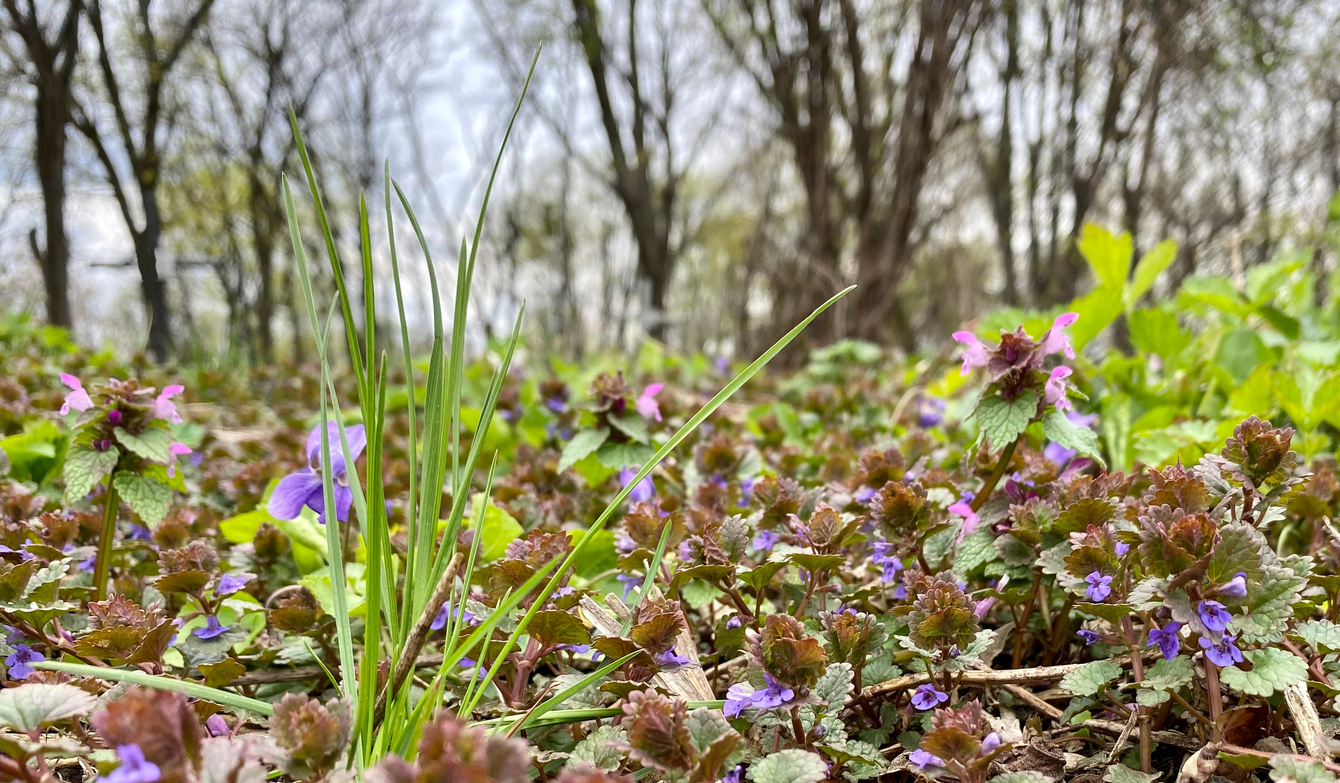
Creeping Charlie is an evergreen perennial with a mat-like cover of small, round, scalloped-edged green leaves punctuated with delicate violet-blue flowers come spring. After flowering, the stem turns downward toward the ground and creeps up to 2-plus feet away to form new roots. A variegated cousin of the weed (often called creeping Jenny) is a popular plant for hanging baskets.
Before You Begin
No matter which method you use to remove creeping Charlie, you’ll want to do it on a day with little to no wind to prevent drift of the seeds on pulled plants or of any weed sprays. Wear gardening gloves and long sleeves when pulling these weeds, since they can cause an itchy rash when handled. If you do resort to using a herbicide, be sure to protect hands, arms, legs, and eyes.
5 Ways to Get Rid of Creeping Charlie
We recommend dealing with invasive plants the same way you’d deal with insect pests: First try methods that are least likely to upset the delicate balance of soil, plant, and animal life. Kaminski always recommends “integrated pest management (IPM) strategies that prioritize cultural and mechanical controls before resorting to chemical solutions.” The five methods below graduate from less harmful hands-on and natural methods to a last-resort chemical option.
1. Remove the weed by hand.
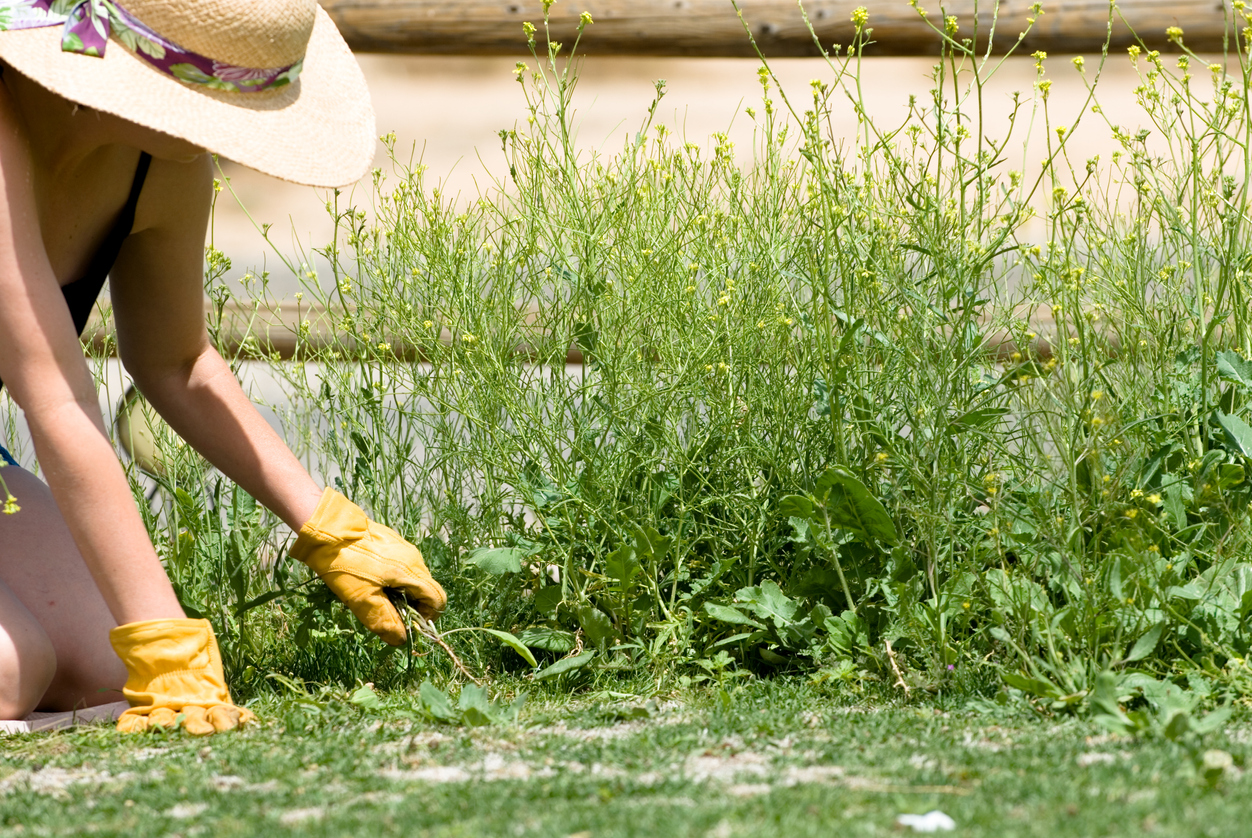
Hand-pulling weeds is the least harmful method to the landscape and environment and the best first approach, especially for a small patch. If the ground is hard and dry, watering the area first to soften it will make for easier yanking. Be aware that the weed can tangle with grass roots, and this method might be tougher in heavily weeded turf.
- Don long sleeves and quality but thin gardening gloves; grab a knee pad for comfort, if you like.
- Prune creeping Charlie to expose the roots by cutting off any loose vines not rooted to the ground.
- Grasp the plant by the roots and pull it out. If the roots are deep, loosen the soil around them with a rooting tool or cultivator.
- Immediately place pulled plants in a disposal bag.
- Check to make sure that you’ve removed all root pieces from the soil.`
When you’ve removed all the creeping Charlie in sight, dig through the soil with your hands or a cultivator to ensure you’ve gotten any root pieces that have broken off, since they will regenerate and you’ll be right back where you started.
2. Smother creeping Charlie with a tarp or cardboard.
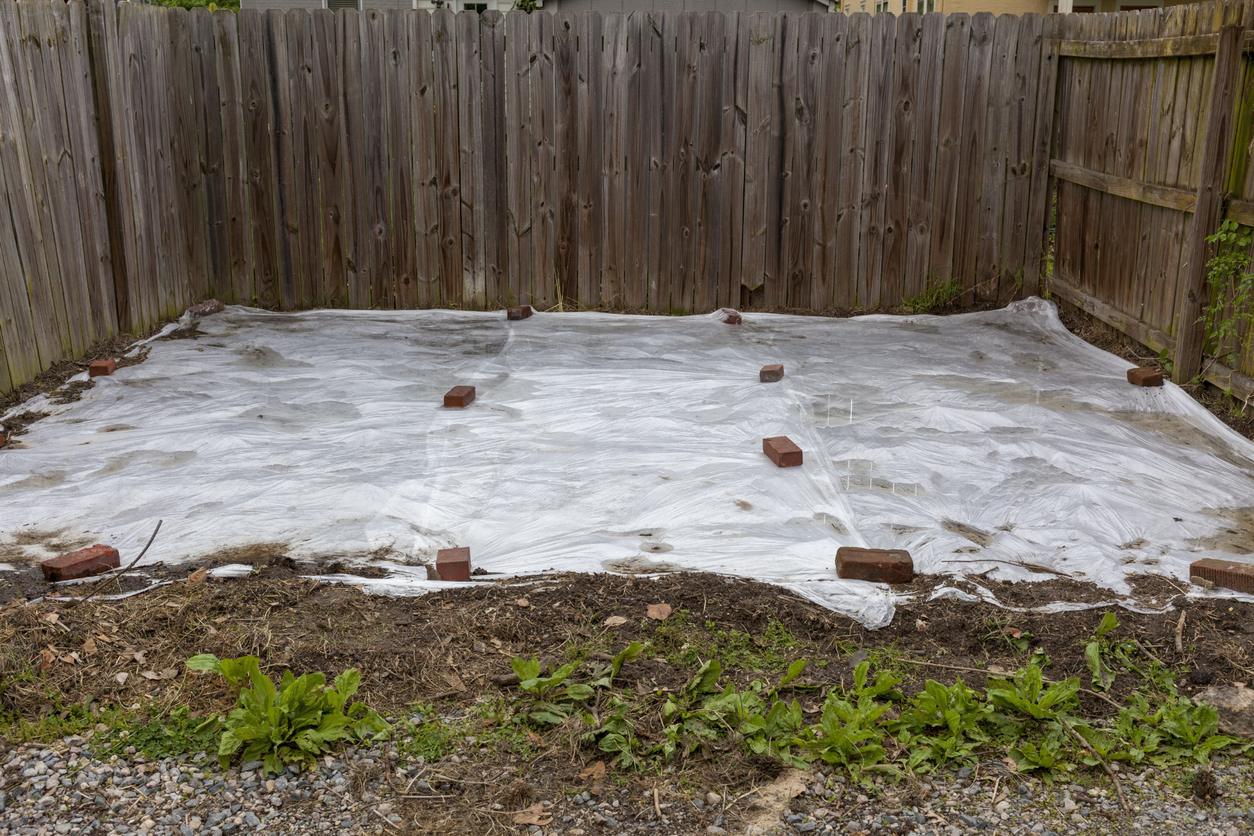
Banish a larger patch of creeping Charlie by depriving it of sunlight for an extended period. Since the weed thrives in shade, cover it and block the sun out completely for this method to be effective. With this method, any other plants mixed in with the weed also will die, so use this only if creeping Charlie has become so invasive that it has taken over or in areas you are willing to reseed grass or other plants after the weed is gone.
- Cover the creeping Charlie with a barrier of newspaper, tarp, or cardboard to completely block sunlight 6 to 12 inches beyond the vines and leaves.
- Weigh the cover down with rocks or bricks to keep it from blowing or shifting.
- Wait at least a week, depending on soil conditions. Peek under the tarp; if there’s any green left, replace the cover for several more days until the plants are shriveled and brown.
- Remove the dead plants by hand. Pull the weeds out of the ground or use a handheld cultivator or stirrup hoe to scrape them out. Skipping this step could allow creeping
- Charlie to grow back from surviving nodes and roots.
- Dispose of the dead plants immediately.
3. Try applying natural weed killers made of household products.
Pulling or smothering creeping Charlie might address the problem, but inevitably some roots or seeds sneak back into your landscape. If those kinder methods haven’t finished the job, many gardeners next turn, with varying success, to the pantry before trying herbicides.
Try eradicating creeping Charlie with a vinegar solution:
- Mix 2 cups of white vinegar with 1 cup of warm water in a spray bottle.
- Spray the leaves and stems thoroughly on a sunny day with little wind.
- Watch every couple of days to see when growth returns.
- Spray the greening areas again and repeat as needed, likely several times.
While certainly more eco-friendly than herbicides, vinegar can harm bees and other pollinators. It also can damage surrounding grass, so think twice before using it in a turf/creeping Charlie mix. Vinegar does not kill roots, so it is less effective against invaders like creeping Charlie. Horticultural vinegar is more concentrated (at 20 percent acidity, rather than 6 to 11 percent acidity found in typical vinegar) and a little more effective. Horticultural vinegar can injure skin and eyes; wear proper eye and skin protection while using it.
Although a few studies have stated that boron (Borax), a laundry soap made of a naturally occurring chemical, is effective at eradicating creeping Charlie, results are mixed. Plus, this solution can harm healthy plants nearby. Boron does not dissipate like vinegar and leaves little room for error if you have plants around the area you treat. It is not approved for weed control.
4. Use a commercial organic contact formula.

The first step to take in applying any commercial creeping Charlie weed killer should be to choose an organic solution. Most of these natural formulas include citric acids or citrus oil (oil is less harmful to bees). Those that also contain iron can be more effective on a broadleaf weed like creeping Charlie. Although organic approaches kill only exposed leaves, not roots, they are safe to apply again according to the directions and are not harmful to the soil and environment.
Follow these guidelines when using an organic weed killer:
- Put on long sleeves, gloves, and goggles to avoid splatter with acetic or citric acid.
- Thoroughly mix the concentrate with water, using the suggested ratio on the container for these hard-to-control weeds.
- Fill a spray bottle or garden sprayer with the solution.
- Spray directly on leaves until they are thoroughly and evenly covered.
- Reapply if large weeds begin to regrow.
5. Apply chemical herbicides as a last resort.
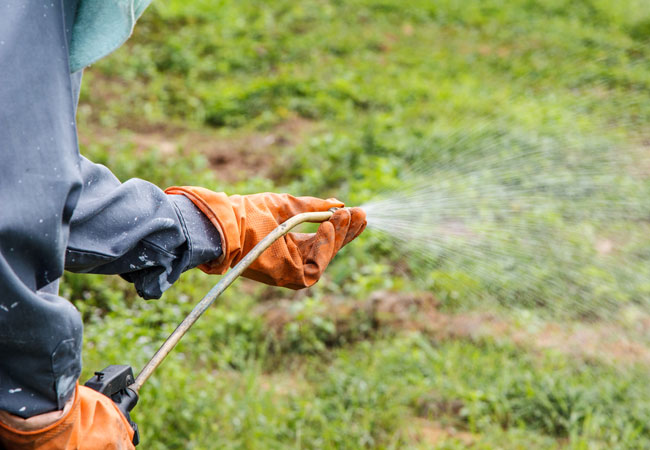
When you’re trying to eradicate large patches of creeping Charlie, natural methods of control might not be effective. since this perennial weed spreads by seeds, rhizomes, and creeping stems that can root where they lie.
If you must resort to an herbicide, know that many of these plant poisons are not selective. Many herbicides, including glyphosate, which we never recommend, kill whatever they touch—not just weeds. The best herbicide for creeping Charlie is one that contains triclopyr, which Kaminski says is “effective against broadleaf weeds like creeping Charlie, but should be used judiciously.”
- Don protective gear, including gardening gloves, clothing, and eyewear, and prep the herbicide. Mix the herbicide in a garden sprayer according to the manufacturer’s directions.
- Apply the herbicide a day before or after the first frost; it will be most effective if you treat the weed when it’s preparing for winter dormancy. If you spray earlier, be sure to spray once again before winter.
- Concentrate the spray on the creeping Charlie, carefully soaking all the leaves while avoiding nearby garden plants (other than grass) as much as possible.
Again, chemical herbicides like triclopyr are the last resort in your weed wars. “The impact on the environment, turf, and wildlife depends on application timing, dosage, and adherence to label instructions,” says Kaminski. Be sure to read and follow the label directions carefully. “Overuse or incorrect application can lead to turf damage, harm to non-target plants, and potential risks to aquatic wildlife if runoff occurs,” he adds.
How to Prevent Creeping Charlie
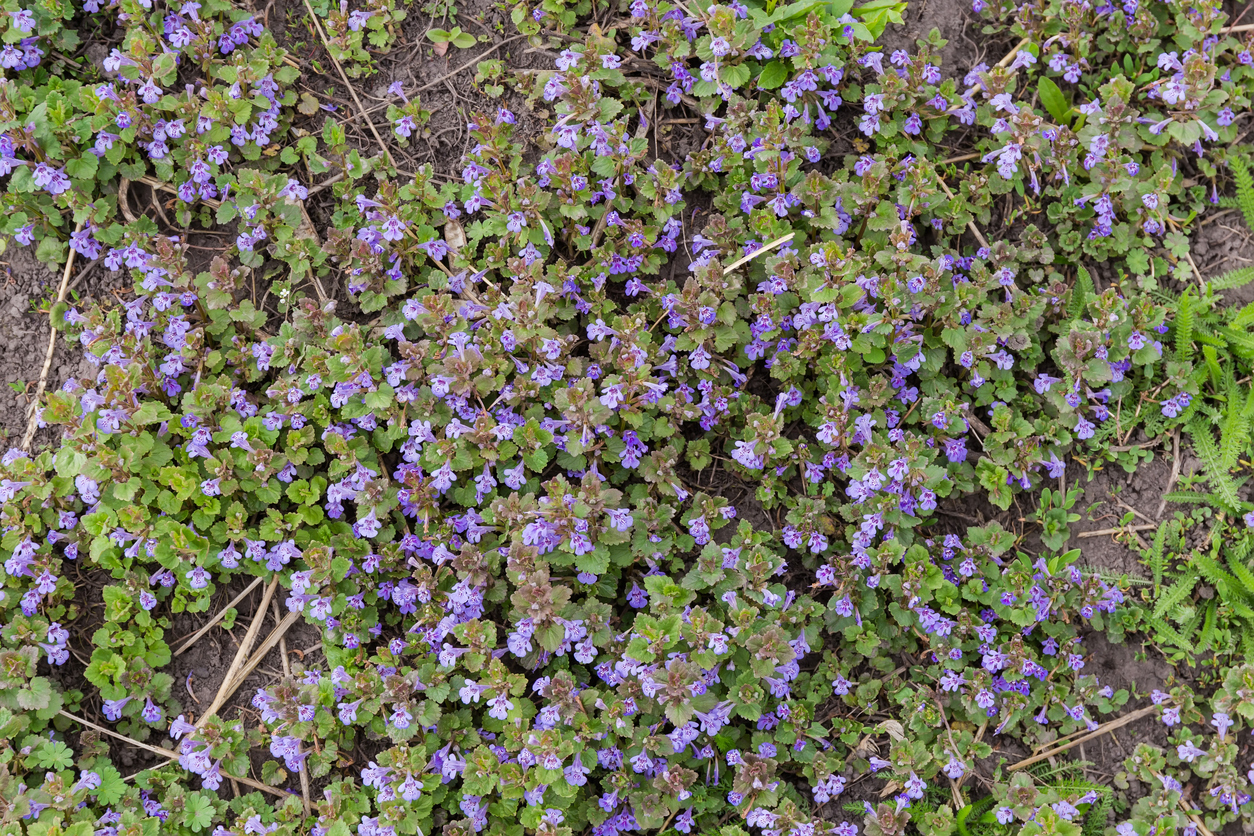
Cultural control—increasing the ability of other plants to compete with weeds like creeping Charlie—is the best prevention. Once you get rid of creeping Charlie, keep it from coming back by promoting a dense and healthy lawn. “Adequate fertilization, correct mowing height, and proper watering practices discourage weed invasion,” says Kaminski. Here are some creeping Charlie prevention tips:
- Maintain the lawn’s overall health. Mulch and aerate as needed.
- Mow grass regularly to a height of 2 to 3½ inches.
- Water the lawn consistently, but avoid creating soggy soil.
- Prune or thin large trees. This will allow more light to reach the ground under them, which will help grasses grow and discourage the growth of creeping Charlie.
- Replace the weed with native alternatives or the right grasses.“In shaded areas where turfgrass struggles, consider planting shade-tolerant ground covers or using mulch to reduce weed establishment,” says Kaminski.
- In beds, consider adding landscape fabric around shrubs (In bare areas) that lets water and light through, but helps suppress weeds. Cover it with a layer of mulch.
Final Thoughts

Getting rid of Creeping Charlie is not easy, but it’s doable for anyone who’s willing to put in the effort. Any of the methods above—hand-pulling, smothering, DIY sprays, organic controls, or broadleaf herbicides—work best on immature plants. If you have to resort to using a chemical creeping Charlie killer, be sure to follow all safety information on the product. Consider, too, consulting local extension experts for further advice. This will help keep you, your family, pets, plants, and the environment safer.
Consider preventing the weed by planting shade-tolerant grasses that can compete with it. Ground cover alternatives include blue phlox (Phlox divaricata) or common blue violet (Viola sororia).

